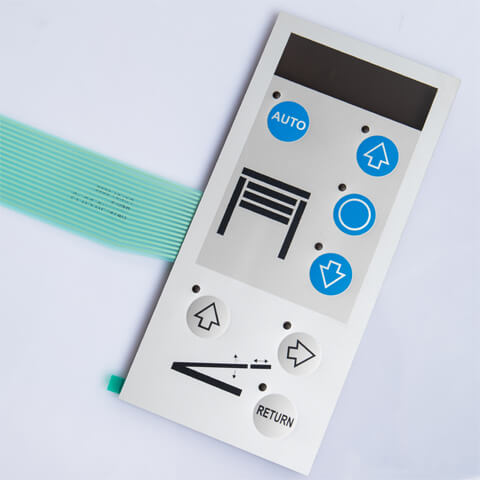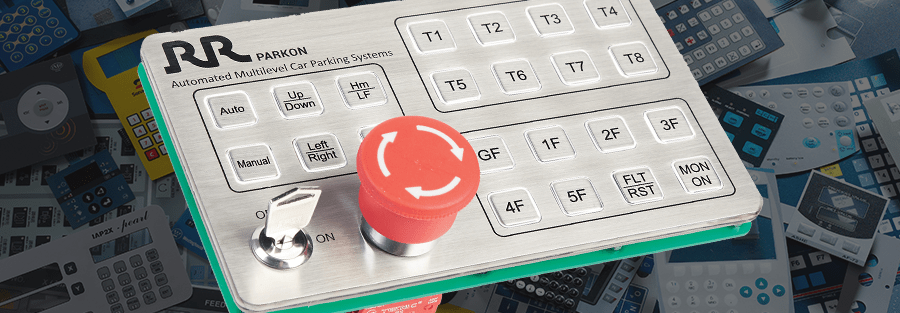Explore Customized Printing and Graphic Overlay Options for Membrane Switches
Discover the Future of Control Interfaces: Why Membrane Switches Are Acquiring Popularity
As markets significantly prioritize effective and straightforward control interfaces, membrane buttons are arising as an engaging option that combines performance with layout adaptability. With the surge of wise technology and sustainability issues, the capacities and developments bordering membrane switches warrant more detailed evaluation.
Recognizing Membrane Layer Buttons
Membrane buttons are important parts in modern-day digital tools, functioning as interfaces between users and devices. These buttons contain numerous layers, typically including a graphic overlay, a spacer layer, and a circuit layer. When a user presses a button on the overlay, the top layer reaches the circuit layer, completing a circuit and sending out a signal to the device. This simple yet effective mechanism enables smooth communication with modern technology.

Toughness is one more vital function, as membrane buttons can be created to resist environmental aspects such as moisture, dirt, and chemicals. This resilience makes them suitable for applications in severe conditions. Overall, comprehending the framework and function of membrane layer switches is vital for valuing their role in the development of user interfaces in today's technology-driven world.
Trick Advantages of Membrane Buttons
Offering a variety of advantages, membrane layer buttons have become a preferred choice in numerous applications (Membrane Switches). Among the primary advantages is their compact style, making it possible for manufacturers to enhance room in tools without compromising performance. Membrane layer buttons are lightweight, which is specifically valuable in portable electronic gadgets

In addition, these buttons provide outstanding sturdiness. Created from flexible materials, they are resistant to dust, moisture, and a variety of environmental factors, making them suitable for harsh conditions. This longevity usually converts into a much longer life-span contrasted to typical mechanical buttons.
In addition, membrane layer changes permit seamless integration of graphics and symbols, supplying visual versatility and improving user experience. Customization options are considerable, making it possible for brand names to create unique user interfaces that straighten with their product identity.
The flat surface area of membrane switches protects against the build-up of dust and grime, making them excellent for hygienic settings. Membrane switches are cost-efficient, as they can be created in high volumes at reduced costs, making them easily accessible for a wide variety of sectors.
Applications Across Industries

A myriad of industries are progressively embracing membrane layer switches because of their versatility and performance. These regulate interfaces are especially widespread in the automotive field, where they are made use of in control panels and infomercial systems, providing a user-friendly and smooth user interface. In the clinical field, membrane changes help with the operation of diagnostic tools and individual monitoring systems, guaranteeing reliability and simplicity of usage in critical circumstances.
Additionally, the consumer electronic devices market benefits from membrane layer switches in devices such as microwaves and push-button controls, enabling structured layout and boosted sturdiness. Membrane Switches. The aerospace market additionally makes use of membrane layer buttons in cabin controls, where space restrictions demand effective and small style services
Furthermore, the industrial industry employs membrane switches in machinery control panels, providing resilience against harsh settings and making certain functional performance. Retail atmospheres have embraced membrane layer switches in point-of-sale systems, enhancing user communication while keeping aesthetic appeal.
Design Fads in Membrane Switches
Evolving alongside technological innovations, layout patterns in membrane buttons are progressively focused on enhancing customer experience and visual appeal. Modern membrane layer buttons are being made go to these guys for simpleness and instinctive usage, allowing customers to browse interfaces easily. This shift in the direction of user-centric my latest blog post style stresses tactile feedback, making certain that individuals receive instant confirmation of their activities.
Furthermore, personalized graphics and colors are becoming typical attributes in membrane switch layouts. This versatility allows makers to create tailored interfaces that straighten with branding and particular customer requirements. The incorporation of backlighting is an additional popular fad, as it not only improves visibility in low-light conditions yet also includes a visually striking aspect to the overall style.
This shift not just boosts aesthetics but additionally adds to the total capability and durability of the buttons. These layout fads jointly highlight the growing value of integrating form and function in the advancement of membrane switches, eventually enhancing the individual experience.
Future Overview for Control Interfaces
The future of control interfaces is poised for significant transformation as arising modern technologies remain to reshape user communications across numerous gadgets. The combination of advanced products, such as conductive inks and flexible electronic devices, will enhance the versatility and capability of membrane switches, making them significantly versatile to a series of applications. Additionally, the surge of the Web of Points (IoT) will certainly drive demand for even more intuitive, user-friendly user interfaces that can perfectly integrate with smart tools.
As synthetic knowledge and maker learning advance, manage user interfaces will likely integrate even more individualized features, permitting individuals to interact with gadgets in ways that are customized to their preferences and routines (Membrane Switches). This change towards user-centric style will certainly place membrane buttons as a principal on the market, specifically in industries like healthcare, automobile, and customer electronics
Moreover, the promote sustainability will encourage makers to discover environment-friendly products and manufacturing approaches, ensuring that the future of control interfaces lines up with ecological factors to consider. In general, as modern technology remains to breakthrough, membrane layer switches will certainly become increasingly sophisticated, paving the way for ingenious control services that improve individual experience and over here operational effectiveness across diverse sectors.
Conclusion
In conclusion, the raising adoption of membrane switches highlights their relevance in the development of control user interfaces. As easy to use interfaces come to be vital in the context of IoT and AI developments, membrane layer switches are placed to play an important role.
As markets increasingly focus on reliable and easy to use control user interfaces, membrane buttons are emerging as an engaging solution that integrates functionality with style flexibility.Toughness is another vital function, as membrane layer switches can be created to stand up to environmental variables such as moisture, dust, and chemicals.Advancing alongside technical innovations, design patterns in membrane layer switches are significantly focused on boosting customer experience and aesthetic appeal. Modern membrane layer switches are being designed for simplicity and intuitive use, permitting individuals to browse user interfaces effortlessly. These design patterns collectively emphasize the expanding significance of integrating kind and feature in the development of membrane switches, eventually enhancing the customer experience.